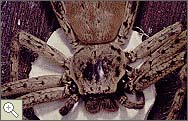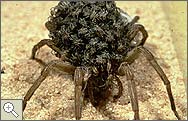
Being a spider means, for the most part, being alone all of your life. That's because spiders, with only a few exceptions, are naturally solitary creatures. They do manage to socialize long enough to court and breed, although even this amount of interaction has its drawbacks for some spiders: after performing their vital services, the males of a few species become the female's next meal. However, by helping nourish the new mom, the male spider contributes to the survival of his offspring.
Spider Moms
Within a few weeks after mating, female spiders are ready to lay their eggs. Many enclose the eggs in a silk sac, called an egg case, that protects them and maintains the correct temperature and humidity for their development. Other females forego building an elaborate case, instead laying the eggs inside their retreats and covering them with silk threads.
Female spiders lay anywhere from a few dozen to several hundred eggs, depending on the species. Once the eggs are laid and the egg case complete, some spiders move on, leaving the future of their progeny to the whims of chance. Others stay with the egg case and guard it until the eggs hatch. And a few, such as wolf spiders, take mothering much further: they carry their egg case, attached to their spinnerets, wherever they go. Then, for a week or so after her spiderlings hatch, a female wolf spider carries her young around too — as many as a hundred or so, all crowded onto her back.
Up, Up, and Away
For many spiders, life starts out with a far-flung adventure. After they hatch, and when they're little more than speck-sized, the spiderlings travel with the wind to strange new lands on a tiny silk filament that they spin for this special purpose.
This spider "flight," called ballooning, can take young spiders high into the atmosphere (ballooning spiders have been caught on airplanes!) and hundreds of miles from their place of origin. Many of the spiderlings don't make it — they end up in water or in a hungry bird's belly, for example — but enough survive to set up shop wherever they may land.
|
 |
 |
 |
 |

This large hunting spider is sitting on top of its egg case.
|
 |
 |

Isopoda goliath
Photo by Dr. Michael Robinson
National Zoological Park
|
 |
 |
 |
 |
 |
 |

Wolf spider with spiderlings on its back.
|
 |
 |

Lycosidae
Photo by Chip Clark
National Museum of Natural History
|
 |
 |
 |
|

